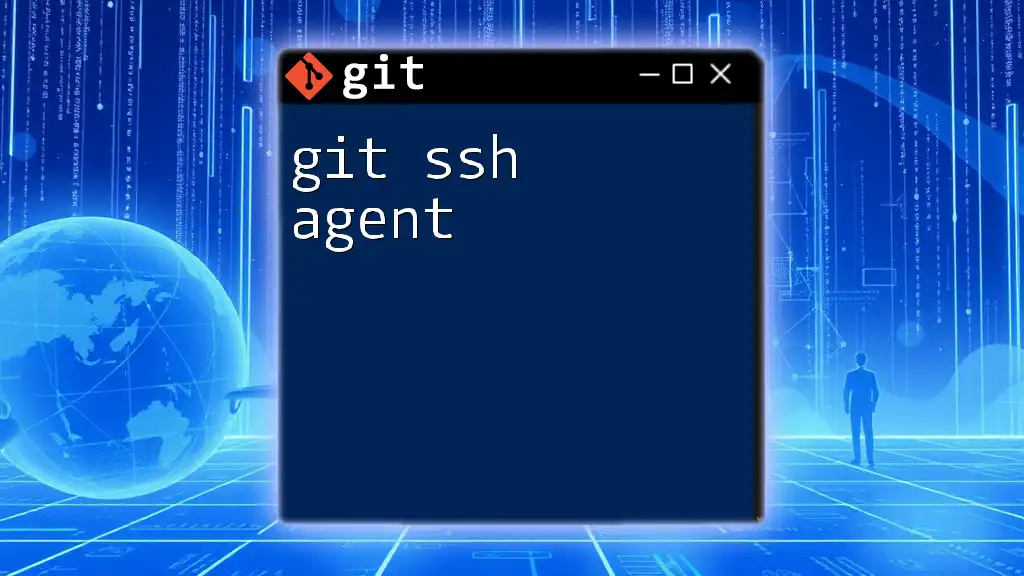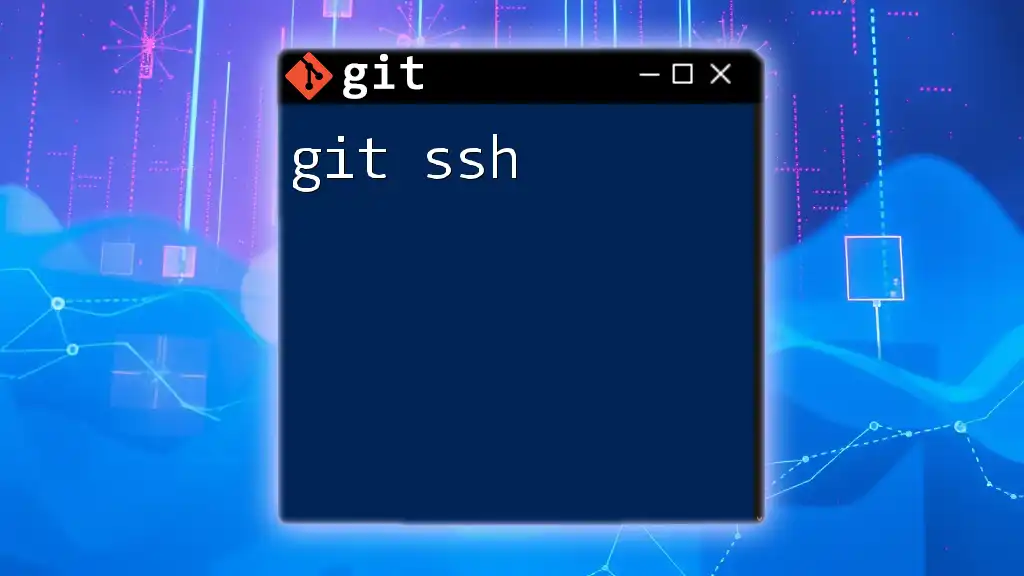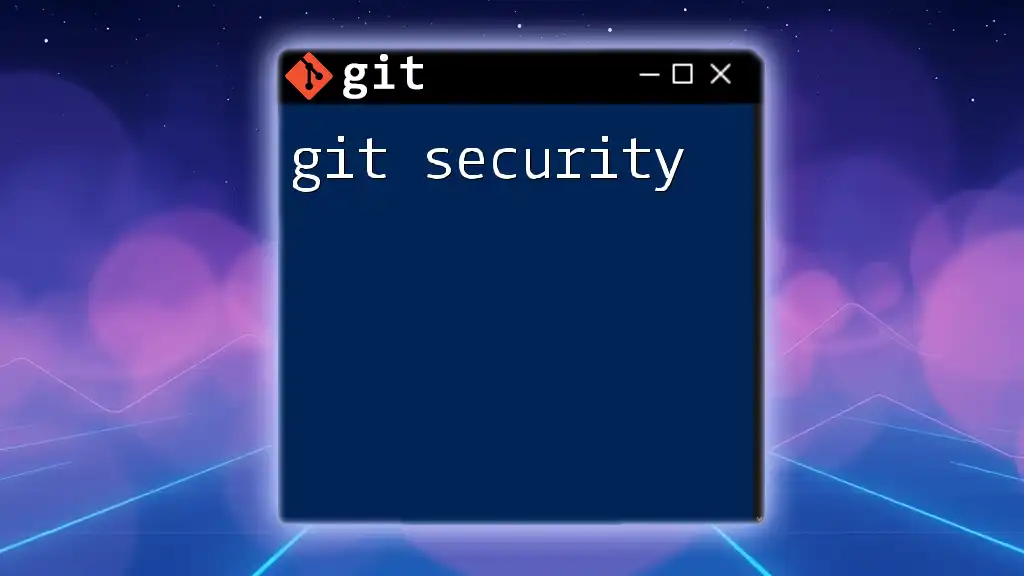In Git, using an SSH proxy allows you to route your Git commands through another server via SSH, which can be useful for accessing repositories in restricted networks.
Here's a basic example of how you might use SSH to connect to a Git repository through a proxy:
ssh -o "ProxyCommand=nc -X connect -x proxy_server:proxy_port %h %p" git@github.com
What is an SSH Proxy?
An SSH Proxy acts as an intermediary that allows you to connect to a remote server through a secure shell (SSH). In the context of Git, it enables you to perform Git operations securely while navigating network complexities, such as those found in corporate environments or regions with internet restrictions.
How SSH Proxy Works with Git
When using Git over SSH, commands are encrypted and sent through the SSH protocol, ensuring that sensitive data remains secure during transmission. Tunneling is the process that allows data to flow securely through the SSH connection. An SSH proxy uses this tunneling to facilitate communication between your machine and the Git server, even when direct access is blocked.
Scenarios Where an SSH Proxy is Necessary
In several scenarios, employing a Git SSH proxy becomes essential:
- Corporate Environments: Companies often impose strict network controls, requiring developers to connect through designated servers.
- Geographical Restrictions: Users in certain countries may encounter limitations that prevent access to popular Git repositories.
- Bypassing Firewalls: When firewalls block direct outbound connections to Git services, a proxy can route the traffic to bypass those restrictions.

Setting Up SSH for Git
Prerequisites
Before diving into the configuration, ensure that you have both Git and an SSH client installed on your machine. This foundation is crucial for the subsequent steps.
Generating SSH Keys
Creating SSH keys is an essential step in securing your authentication to Git repositories. Follow these instructions carefully:
To generate your SSH key pair, use the following command:
ssh-keygen -t rsa -b 4096 -C "your_email@example.com"
In this command:
- `-t rsa`: Specifies the type of key to create. RSA is a widely used encryption standard.
- `-b 4096`: Determines the key size (4096 bits is recommended for strength).
- `-C`: Adds a label or comment to the key for identification.
After executing the command, you will be prompted to choose a file for saving the key. Press Enter to use the default location.
Then, add your SSH key to the SSH agent with these commands:
eval "$(ssh-agent -s)"
ssh-add ~/.ssh/id_rsa
Adding SSH Key to Git Provider
Once the SSH key has been generated, you need to add it to your Git provider account for it to be recognized during operations. Here’s how to do this for some popular platforms:
- GitHub: Go to `Settings` > `SSH and GPG keys`, click `New SSH key`, and paste your public key from `~/.ssh/id_rsa.pub`.
- GitLab: Navigate to `Preferences` > `SSH Keys`, and paste your public key in the respective field.
- Bitbucket: In `Personal settings`, find `SSH keys`, and add your public key.
Differences in Processes for Each Provider
While the steps above generally apply, there may be slight variations in terms of navigation and labeling on different interfaces. Always refer to the respective documentation of your Git provider for the latest guidance.

Configuring Git to Use an SSH Proxy
What is the ProxyCommand?
The `ProxyCommand` is a directive in your SSH configuration file that specifies how to establish an SSH connection through a proxy. This is an essential component when configuring Git to communicate over an SSH proxy.
Setting Up Your SSH Config File
Configuring your `~/.ssh/config` file is the next step. Open this file in your preferred text editor, and add the configuration for your Git provider alongside the proxy settings. Here’s a sample configuration:
Host github.com
HostName github.com
User git
IdentityFile ~/.ssh/id_rsa
ProxyCommand nc -x proxyserver:port %h %p
In this configuration:
- `Host`: An alias for your host (in this case, GitHub).
- `HostName`: The actual domain name of the service.
- `User`: The username for the SSH connection.
- `IdentityFile`: The path to your private key.
- `ProxyCommand`: The command to use for making the connection through a proxy, using `nc` (netcat).
Replace `proxyserver` and `port` with your actual proxy server's address and port number.

Testing the SSH Proxy Configuration
Once your SSH config file is set up, it’s crucial to test whether your configuration is working correctly. Execute the following command in your terminal:
ssh -T git@github.com
If everything is functioning properly, you should see a success message, confirming your authentication.
Troubleshooting Common Issues
If you encounter errors such as:
- Connection refused: Verify your proxy settings, ensuring they are correct.
- Authentication errors: Double-check that your SSH keys are correctly added to your Git provider's account and that your local configuration is accurate.

Use Cases for Git SSH Proxy
Corporate Environment
In a corporate setting, developers may face network restrictions that prevent direct access to Git repositories. Setting up a Git SSH proxy enables them to conduct their work without hassle, facilitating a necessary bridge to collaboration tools and repositories.
Developers in Restricted Areas
For developers in regions experiencing heavy restrictions on internet access, an SSH proxy can become an invaluable tool. It allows them to connect to platforms like GitHub or GitLab without needing to compromise on security or functionality.

Security Considerations
Risks Involved with SSH Proxies
While employing an SSH proxy can enhance accessibility, it's essential to consider potential security risks. Using a secured proxy, such as one authenticated through SSH, can mitigate these risks, but you should remain vigilant.
Best Practices for Securing Your SSH Proxy Setup
To ensure a secure SSH proxy environment:
- Consider using VPNs alongside your SSH proxy for an added layer of security.
- Regularly update your SSH keys and maintain a secure approach to key management.
Keeping Your SSH Keys Safe
Good practices in key management include:
- Use a strong passphrase when creating SSH keys for additional security.
- Utilize tools designed for key management, ensuring to monitor and rotate keys periodically.

Conclusion
In summary, understanding and implementing a Git SSH proxy is crucial for developers facing access challenges. This comprehensive guide has provided you with the tools and knowledge to leverage SSH effectively, enabling a smooth and secure experience with Git repositories.
By following the outlined steps and security practices, you can ensure a robust Git workflow, even in restrictive environments. Start applying what you've learned today, and look for additional resources to further your knowledge on this essential topic.

















